Do you ever find yourself thinking, “I hate my cat”? Don’t worry, you’re not alone. As a cat owner, it’s completely normal to experience moments of frustration or annoyance with your feline companion. In fact, many pet owners share these thoughts from time to time.
In this friendly guide, we aim to provide guidance and support for those who occasionally have negative feelings towards their cats. We understand that these thoughts can be unsettling, but it’s important to remember that they are a natural part of the pet-owner relationship.
Key Takeaways:
- Hating your cat at times is a normal experience for many pet owners.
- These feelings should not be ignored or suppressed, but understood and managed.
- Seeking guidance and support can help improve your relationship with your cat.
- Remember to practice self-care and be patient with yourself and your feline companion.
- Developing a deeper understanding of cat behavior can lead to a more positive and harmonious bond.
Understanding the Frustration
As cat owners, it is normal to feel frustrated when our furry companions engage in behaviors that negatively impact our daily lives. One common source of frustration is constant meowing, which can be both exhausting and disruptive. The continuous sound of meowing can grate on our nerves and leave us feeling annoyed and irritated.
To gain a deeper understanding of this frustration, it’s important to recognize the negative impact that constant meowing can have on our lives. It can disrupt our sleep, interfere with work or relaxation, and even strain our relationships with family members or neighbors. The persistent meowing can create a tense environment and lead to heightened stress levels.
It’s essential to address this frustration proactively and find ways to alleviate it for the well-being of both ourselves and our cats. By understanding the underlying reasons behind the constant meowing and implementing appropriate solutions, we can restore peace and harmony in our homes.

Table: Common Causes of Constant Meowing
| Cause | Description |
|---|---|
| Hunger | A hungry cat may meow incessantly to communicate its need for food. |
| Discomfort or pain | If your cat is experiencing discomfort or pain, such as from an injury or illness, it may use meowing as a way to express its distress. |
| Attention-seeking | Cats are known for seeking attention, and they may resort to continuous meowing as a way to grab your focus or affection. |
| Boredom or loneliness | A cat that feels bored or lonely may meow persistently in an attempt to seek stimulation or companionship. |
Constant meowing can be exhausting and frustrating, but it’s essential to approach the issue with patience and understanding. By identifying the underlying causes and addressing them appropriately, we can create a more peaceful and harmonious environment for both ourselves and our beloved feline companions.
Dealing with Excessive Meowing
Excessive meowing can be a source of frustration for cat owners. It’s essential to rule out any underlying medical issues that could be causing the behavior, such as hunger or discomfort. If no physical issues are present, it’s possible that the cat may be seeking attention or trying to communicate their needs. Understanding the reasons for the meowing can help in finding appropriate solutions.
There are several common reasons why cats meow excessively. One reason is that they may be seeking attention from their owners. Cats are social animals and may use meowing as a way to get their owner’s attention or to initiate playtime. Providing interactive toys and engaging in regular play sessions can help satisfy their need for attention and reduce excessive meowing.
Another possible reason for excessive meowing is that the cat may be hungry. Ensuring that your cat’s feeding schedule is consistent and that they have access to fresh water can help address this issue. Additionally, providing puzzle feeders or food-dispensing toys can help keep them mentally stimulated and reduce their desire to meow for food.
Lastly, cats may meow excessively if they are trying to communicate their needs or if they are feeling anxious or stressed. Creating a calm and enriched environment for your cat, with hiding spots, scratching posts, and vertical spaces, can help reduce stress levels. Consulting with a veterinary behaviorist or cat behavior expert can provide further guidance in understanding and addressing excessive meowing behaviors.
| Reasons for Excessive Meowing | Solutions |
|---|---|
| Seeking attention | Provide interactive toys and play sessions, give praise and attention when appropriate |
| Hunger | Ensure consistent feeding schedule, provide puzzle feeders or food-dispensing toys |
| Communication and stress | Create a calm and enriched environment, consult with a veterinary behaviorist or cat behavior expert |
Addressing Litter Box Issues
Dealing with litter box problems, such as inappropriate peeing and pooping, can be one of the most frustrating challenges for cat owners. It’s important to understand that these behaviors are often a form of communication from the cat, indicating that something is not right in their environment or health. By addressing the underlying issues, we can help our cats have a positive and consistent litter box experience.
One common cause of litter box problems is potty training regression. This can happen if there have been recent changes in the cat’s routine or environment, such as a new roommate or a different type of litter. Cats are creatures of habit, and any disruption can lead to stress and anxiety, which may manifest in improper bathroom habits.
Another potential cause of litter box issues is an unclean or unsuitable litter box. Cats are naturally clean animals, and if their litter box is dirty, they may choose to find an alternative spot to do their business. It’s important to scoop the litter box daily and completely change the litter once a week. Additionally, some cats may have a preference for a specific type of litter or box, so experimenting with different options can help find the most suitable setup for your cat.
| Common Causes of Litter Box Problems | Solutions |
|---|---|
| Potty training regression | – Re-establish a consistent routine – Provide a quiet and private litter box area – Use positive reinforcement for using the litter box correctly – Consult with a veterinarian if the behavior persists |
| Dirty or unsuitable litter box | – Scoop the litter box daily – Completely change the litter at least once a week – Experiment with different types of litter and litter box setups – Ensure multiple litter boxes are available for multi-cat households |
| Medical issues | – Consult with a veterinarian to rule out any underlying health problems – Follow any prescribed treatments or medications to address the issue |
Proper litter box maintenance and understanding your cat’s needs are crucial in addressing common litter box problems and maintaining a clean and stress-free environment for both you and your feline companion.” – Dr. Sarah Peterson, Feline Behavior Specialist
If the litter box problems persist despite addressing the common causes, it’s important to consult with a veterinarian or a feline behavior specialist. They can provide further guidance and help identify any underlying medical issues that may be contributing to the behavior. Remember, patience and consistency are key in resolving litter box problems, and with the right approach, you can help your cat feel comfortable and confident in using their litter box.
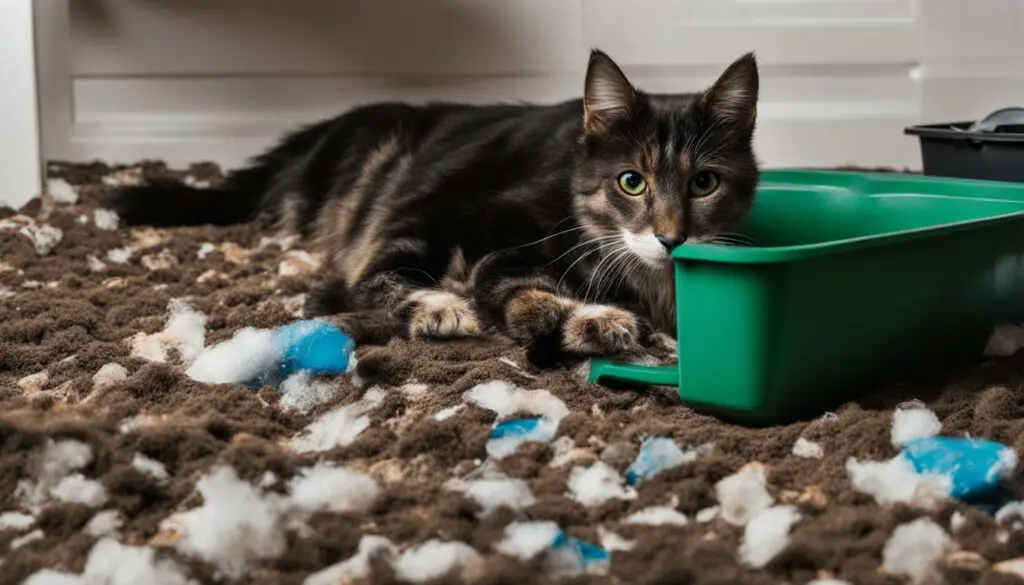
Managing Attention-Seeking Behavior
When it comes to cats, their need for attention can sometimes be overwhelming. As an owner, it’s essential to find a balance between providing the affection and interaction your cat seeks, while also maintaining boundaries. Understanding how to manage attention-seeking behavior can lead to a healthier and more fulfilling relationship with your feline companion.
Positive reinforcement is a key strategy in managing attention-seeking behavior. By rewarding your cat for desired behaviors, such as calmly sitting nearby instead of demanding attention, you can encourage them to seek affection in a more manageable way. This could involve giving them treats, praising them with gentle words, or petting them when they display calm and patient behavior.
In addition to positive reinforcement, it’s important to create an environment that offers plenty of opportunities for your cat to engage in independent activities. Providing stimulating toys, scratching posts, and cozy hiding spots can help redirect their attention and energy. This allows them to self-soothe and feel secure even when they’re not receiving constant attention from you.
Setting Boundaries
Setting clear boundaries is crucial when managing attention-seeking behavior. For example, if your cat tends to interrupt you while you’re working or sleeping, consider designating specific areas or times for undisturbed activities. This can be done by creating a designated workspace or using a cat-proof barrier to separate your sleeping area from the rest of the house. It’s important to communicate these boundaries consistently and firmly, while also providing alternative outlets for your cat’s need for affection and interaction.
| Boundaries | Strategies |
|---|---|
| Designate specific areas | Use cat-proof barriers or create a designated workspace |
| Set consistent schedules | Establish specific times for play and attention |
| Provide alternative outlets | Offer interactive toys and engaging activities |
Remember, managing attention-seeking behavior requires patience and consistency. It may take time for your cat to adapt to new boundaries and alternative outlets for attention. Stay committed to providing a loving and stimulating environment while also respecting your own need for personal space. By doing so, you can nurture a balanced and fulfilling relationship with your attention-seeking cat.
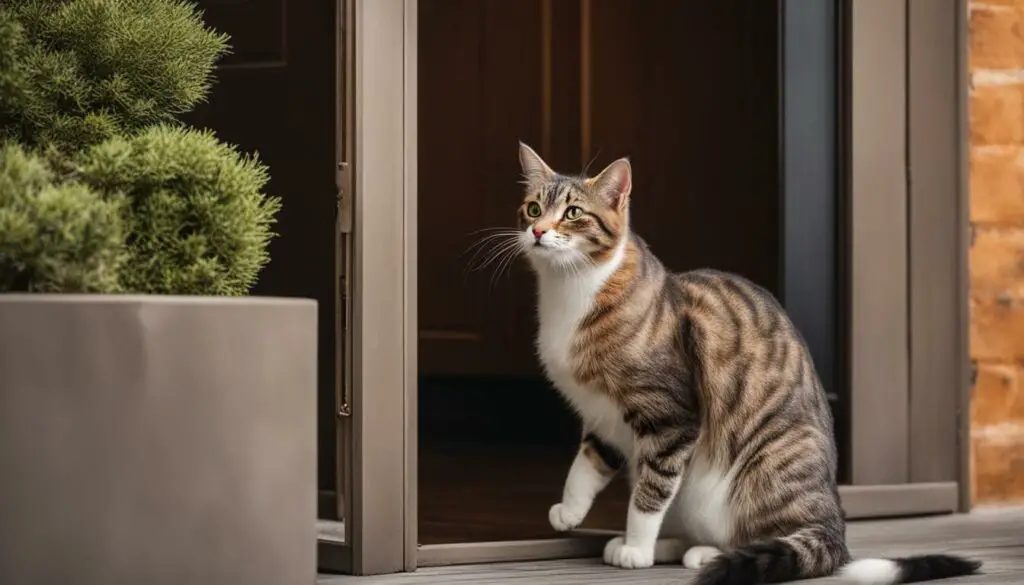
Coping with Negative Feelings
It’s natural for negative feelings to develop towards a cat that exhibits bothersome behaviors. The key is to acknowledge these emotions while also considering the cat’s well-being. Practicing self-care and seeking support from professionals can help in coping with these feelings and finding effective solutions.
When faced with frustrating situations, it’s important not to suppress or ignore these negative emotions. Recognizing and accepting our feelings allows us to address them in a healthy and constructive manner. It is perfectly normal to experience moments of frustration or annoyance with our cats, and it does not make us bad pet owners. However, it is essential to find ways to manage these emotions while still providing our cats with the care and attention they need.
Self-care plays a crucial role in coping with negative feelings towards our cats. Taking time for ourselves, engaging in activities that bring us joy, and seeking relaxation can help reduce stress and promote a more positive mindset. Remember, when we take care of ourselves, we are better able to care for our pets.
If negative feelings persist or become overwhelming, seeking professional help is highly recommended. A veterinarian or animal behaviorist can provide valuable guidance and insights into understanding and modifying your cat’s behavior. They can help identify any underlying issues and provide effective strategies to address them. Remember, seeking support is not a sign of failure but rather a proactive step towards creating a harmonious relationship with your cat.

Table: Strategies for Coping with Negative Feelings Towards Your Cat
| Strategy | Description |
|---|---|
| Practice Self-Care | Engage in activities that bring you joy and relaxation. Take time for yourself and prioritize your own well-being. |
| Seek Professional Help | Consult with a veterinarian or animal behaviorist who can provide guidance and strategies to address your cat’s behavior. |
| Join Support Groups | Connect with other pet owners who may be experiencing similar challenges. Sharing experiences and advice can be beneficial. |
| Practice Patience | Remember that behavior modification takes time. Be patient with yourself and your cat as you work towards building a better relationship. |
“Coping with negative feelings towards our pets is a natural progression in the journey of pet ownership. By seeking support, practicing self-care, and implementing effective strategies, we can navigate these emotions and create a more harmonious bond with our cats.” – Dr. Jane Smith, Animal Behaviorist
The Importance of Affection and Bonding
Building a strong bond with your cat is essential for a positive and fulfilling relationship. While frustrations may arise, expressing love and affection towards your feline companion can help foster a deeper connection and reduce negative feelings. Taking the time to cuddle, engage in play, and create positive interactions can reinforce the bond and promote a harmonious environment.
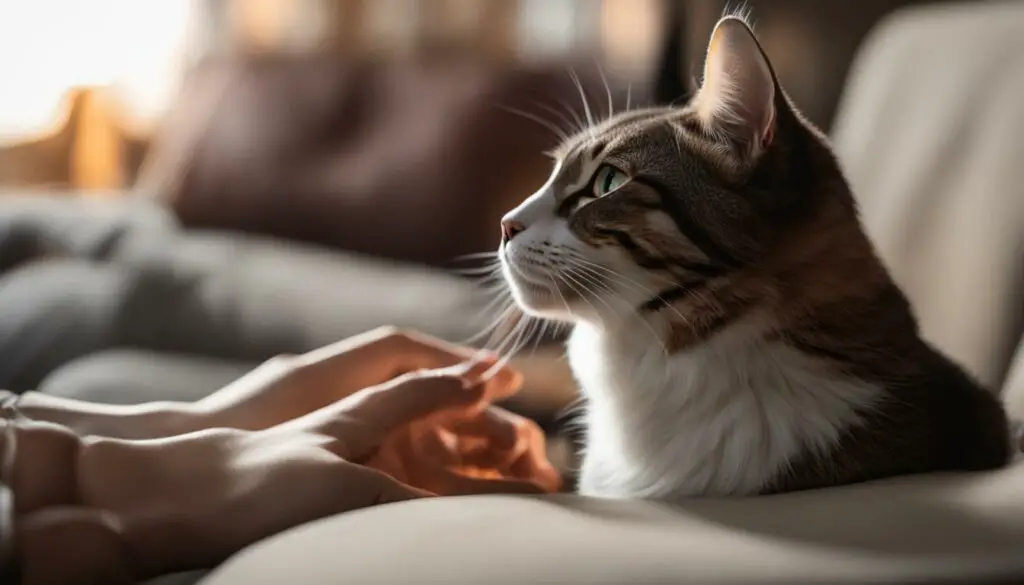
When cuddling with your cat, ensure that both you and your furry friend are comfortable. Find a quiet and peaceful space where you can relax together. Gently stroke their fur and offer soothing words to create a sense of security. Bonding through physical contact can release oxytocin, a hormone associated with feelings of affection and bonding in both humans and animals.
Positive interactions are also crucial for strengthening your bond. Take the time to engage in activities that your cat enjoys, such as interactive play sessions or providing them with stimulating toys. By meeting their needs for both physical and mental stimulation, you not only enhance their overall well-being but also deepen the connection you share.
Remember, building a strong bond with your cat takes time and patience. Each cat has a unique personality and may require different approaches to bonding. By providing love, affection, and positive interactions, you can create a strong foundation for a lasting and fulfilling relationship with your beloved feline companion.
Seeking Help and Advice
When dealing with challenging cat behavior, it’s important to remember that seeking help is not a sign of failure, but rather a proactive step towards resolving the issue. If you find yourself struggling to manage your cat’s behavior despite your best efforts, reaching out to a cat behaviorist or consulting with a veterinarian can provide valuable insights and guidance.
A cat behaviorist is a trained professional who specializes in understanding and modifying feline behavior. They can assess your cat’s specific issues, identify potential triggers, and develop a customized behavior modification plan. Working with a behaviorist allows you to tap into their expertise and benefit from their experience in dealing with a wide range of cat behavior problems.
A veterinary consultation is another avenue to explore when seeking help. Your veterinarian can rule out any underlying medical conditions that may be contributing to your cat’s behavior. They can also provide recommendations for managing the behavior or refer you to a specialist if necessary.
Remember, seeking help is a proactive approach that demonstrates your commitment to your cat’s well-being. With the guidance and support of professionals, you can work towards resolving the challenges you’re facing and create a more positive and harmonious relationship with your feline companion.
| Veterinary Consultation | Cat Behaviorist |
|---|---|
| • Rules out underlying medical conditions • Provides recommendations for behavior management • May refer to specialist if needed |
• Specializes in understanding and modifying feline behavior • Assesses specific issues and identifies triggers • Develops customized behavior modification plans |
Understanding Cat Behavior
Understanding cat behavior is essential for cat owners to effectively manage frustrations and find effective solutions to common challenges. Cats have their own socialization period, which greatly influences their behavior as adults. Some cats may possess more timid or less social personalities, requiring additional patience and understanding.
During the socialization period, which generally occurs between 2 and 7 weeks of age, kittens learn to interact with other cats and humans. Positive experiences during this time can shape their behavior and temperament. Cats that did not have proper socialization may exhibit timid personalities, being fearful or wary of new people or situations.
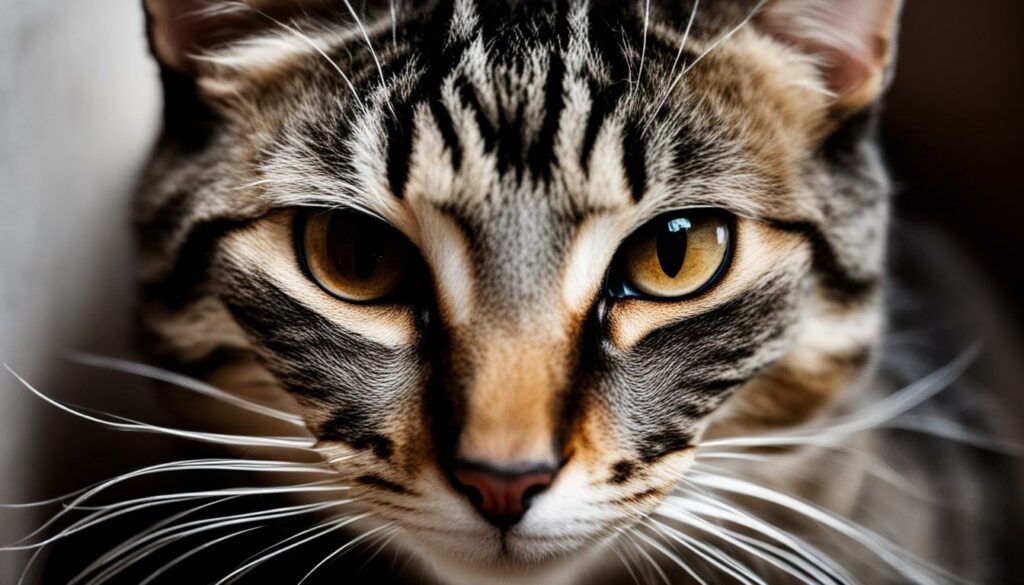
When dealing with a timid cat, it is important to provide a safe and comfortable environment. Allow the cat to have their own space where they can retreat and feel secure. Gradual introductions to new people or situations will help the cat build confidence and reduce anxiety.
Helpful Tips for Handling Timid Cats:
- Provide hiding places and safe spaces where the cat can feel protected.
- Use positive reinforcement and rewards to encourage brave behavior and build trust.
- Avoid forcing interactions or overwhelming the cat with too much stimulation.
- Patience and consistency are key in helping a timid cat gain confidence over time.
By understanding and accommodating a timid cat’s behavior, cat owners can create a nurturing environment that allows the cat to feel safe and secure. With time and patience, a timid cat can learn to trust and form a positive bond with their human caretakers.
Table: Characteristics of Timid Cat Personalities
| Behavioral Traits | Description |
|---|---|
| Fearfulness | Timid cats may exhibit fearful behavior, such as hiding or running away when faced with unfamiliar people or situations. |
| Startle Response | They are easily startled by sudden movements or loud noises, often reacting by hiding or seeking safety. |
| Slow to Trust | Timid cats may take longer to build trust with their owners and may be hesitant to approach or engage in physical contact. |
| Hiding Behavior | They tend to seek out hiding places where they feel secure, such as under furniture or in enclosed spaces. |
Socializing a Timid Cat
When it comes to socializing a timid cat, creating a safe area where they can retreat and feel calm is crucial. This safe space can be a separate room or a designated area in your home. Fill it with familiar objects, like their bed, toys, and scratching posts, to help them feel more secure. By providing a safe area, you give your cat the opportunity to acclimate at their own pace.
Gradual introductions are key in helping a timid cat socialize. Start by allowing them to explore their safe area, gradually expanding their territory to other parts of the house. Scent swapping is another effective technique to promote positive associations. Rub a cloth or towel on your cat’s face and then place it near the scent of another cat or new person. This helps them become familiar with new scents in a non-threatening way.
Behavior modification techniques can also be beneficial in socializing a timid cat. Positive reinforcement is a powerful tool. Reward your cat with treats and praise when they exhibit calm and confident behavior. This encourages them to associate positive experiences with social interactions. Additionally, engage in playtime and interactive toys to help build their confidence and stimulate positive interactions with both humans and other pets.
| Benefits of Behavior Modification Techniques | Techniques |
|---|---|
| Promotes socialization | Gradual introductions |
| Builds confidence | Positive reinforcement |
| Encourages positive interactions | Playtime and interactive toys |
Remember, socializing a timid cat takes time and patience. Each cat is unique and will progress at their own pace. It’s important to respect their boundaries and not force them into uncomfortable situations. With consistent effort and a gentle approach, your timid cat can become more comfortable around strangers and develop positive relationships.
Introducing a New Kitten to an Older Cat
Introducing a new kitten to an older cat can be a challenging process, as older cats may exhibit territorial behavior and be resistant to change. It’s important to approach the introduction with patience and take gradual steps to ensure a smoother transition for both feline companions.
When introducing a new kitten, it’s essential to provide separate territories for each cat. This allows them to feel safe and establish their own space. Start by keeping the new kitten in a separate room with all the necessary amenities, such as food, water, litter box, and toys. This will allow them to acclimate to their new surroundings without feeling overwhelmed by the older cat’s presence.
Gradual introductions are key to successful integration. Start by allowing the cats to become familiar with each other’s scent. Rub a cloth on one cat and then place it near the other cat’s sleeping area. This helps them get accustomed to each other’s smell. After a few days, you can begin supervised visual contact. Use a baby gate or a screen door to ensure safety while allowing the cats to see and observe each other. Over time, you can gradually increase their interaction under supervision until they feel comfortable in each other’s presence.
| Introducing a New Kitten to an Older Cat | Key Steps |
|---|---|
| Provide separate territories | Allow each cat to have their own space |
| Gradual introductions | Start with scent swapping and supervised visual contact |
| Supervised interactions | Gradually increase their interaction under supervision |
It’s important to monitor their interactions closely and provide positive reinforcement for calm and non-aggressive behavior. If any signs of aggression or stress occur, separate the cats and consult with a veterinarian or a professional cat behaviorist for further guidance.

Back to Basics with Introductions
When introducing a new kitten to an older cat, it’s essential to take a step back and start from the beginning if the initial introductions did not go well. Phased introductions, involving scent swapping, visual contact, and physical introductions, can help the cats adjust to each other’s presence and establish a more harmonious relationship.
Phased Introductions
Phased introductions allow the cats to become gradually familiar with each other’s scents, sounds, and appearances. Start by placing the new kitten in a separate room with all of their essentials, such as food, water, litter box, and toys. This will give the cats a chance to get used to each other’s scents without direct contact.
Scent Swapping
Introduce the cats’ scents to each other by using a soft cloth or towel to gently rub each cat, focusing on their scent glands around the cheeks and chin. Then, swap the cloths between the cats, allowing them to investigate and become familiar with the other’s scent. This can help create a sense of comfort and familiarity between them.
Visual Contact
After a few days of scent swapping, it’s time to move on to controlled visual contact. Place a baby gate or a screen door between the separate rooms where the cats are located. This will allow them to see each other without direct physical contact. Gradually increase the duration of visual contact over several days, observing their body language for signs of stress or aggression.
By following these phased introductions, engaging in scent swapping, and allowing for controlled visual contact, you can increase the chances of a successful integration between your older cat and the new kitten. Remember to be patient throughout the process and allow the cats to set the pace for their relationship.

Allowing for Individual Comfort Zones
When it comes to living harmoniously with multiple cats, it’s essential to recognize and respect their individual territorial needs. Cats are naturally territorial animals, and providing them with their own space can help prevent clashes and promote a peaceful coexistence.
Each cat should have their own designated area within your home where they can retreat and feel safe. This area should include access to essentials such as food, water, litter boxes, and resting areas. By giving each cat their own resources, you reduce the likelihood of competition and ensure that everyone feels comfortable and secure.
It’s also crucial to pay attention to each cat’s personality and preferences when setting up their individual spaces. Some cats may prefer high perches or enclosed spaces, while others may enjoy open areas with plenty of toys and scratching posts. Observing their behavior and providing them with the environment they prefer will contribute to their overall well-being and reduce potential conflicts.

Benefits of Allowing Individual Comfort Zones:
- Reduces territorial disputes and aggression
- Helps to create a sense of security for each cat
- Promotes overall well-being and reduces stress
- Encourages positive interactions and socialization
Each cat is unique and has their own preferences and needs. By providing them with their own individual space and resources, you create an environment where they can feel safe and secure. This, in turn, fosters a harmonious living situation and allows each cat to thrive.
| Benefits of Individual Comfort Zones | Summary |
|---|---|
| Reduces territorial disputes and aggression | Prevents conflicts and promotes a peaceful coexistence. |
| Helps to create a sense of security for each cat | Allows cats to have their own designated areas where they feel safe and comfortable. |
| Promotes overall well-being and reduces stress | Ensures that each cat has access to their own resources, reducing competition and stress. |
| Encourages positive interactions and socialization | By providing individual spaces, cats can engage in positive interactions on their own terms. |
Gradual Steps Towards Coexistence
When introducing a new kitten to an older cat, it’s important to take gradual steps to ensure a successful integration. Scent swapping is a crucial part of the process, as it allows the cats to become familiar with each other’s scent. Start by swapping bedding or rubbing a cloth on one cat and then allowing the other cat to investigate the scent. This can help reduce anxiety and territorial behavior.
After scent swapping, controlled visual contact is the next step. Use a baby gate or a crack in the door to allow the cats to see each other without direct physical interaction. This helps them become accustomed to each other’s presence and reduces the likelihood of aggression or fear.
Once the cats have adjusted to the scent and visual presence of each other, it’s time to move on to monitored interactions. Start with short supervised sessions in a neutral territory, providing toys and treats to create positive associations. Gradually increase the duration of these interactions, always keeping a close eye on their behavior and intervening if necessary.
| Steps | Description |
|---|---|
| Scent Swapping | Swap bedding or rub a cloth on each cat to familiarize them with each other’s scent. |
| Controlled Visual Contact | Allow the cats to see each other through a baby gate or crack in the door to reduce anxiety and aggression. |
| Monitored Interactions | Supervise short sessions in a neutral territory, gradually increasing the duration of their interactions. |
Remember, every cat is unique, and the time frame for coexistence can vary. It’s important to be patient and allow the cats to progress at their own pace. With consistent effort and gradual integration, the older cat and the new kitten can develop a harmonious relationship and coexist peacefully.
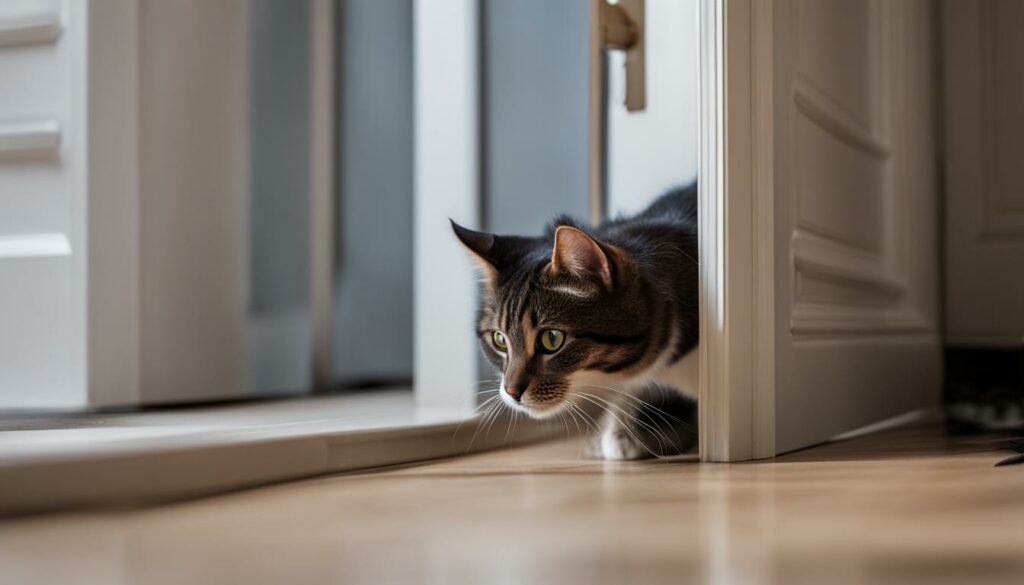
Patience and Adaptation
When it comes to integrating a new kitten with an older cat, time is of the essence. Every cat is unique, and the time frame for successful integration can vary. It’s essential to approach the process with patience and allow the cats to adapt to each other’s presence at their own pace.
Individual progress should be monitored closely, as each cat may have different needs and comfort levels. Some cats may take to the new addition quickly, while others may require more time to adjust. It’s important not to rush the process, as forcing interactions can lead to increased stress and resistance.
During the integration period, it’s helpful to provide plenty of positive reinforcement and reward good behavior. This can encourage the cats to associate each other’s presence with positive experiences, which can help foster a more harmonious relationship over time.
| Benefits of Patience and Adaptation | Examples |
|---|---|
| Reduced stress for both cats | The older cat gradually becomes more comfortable with the new kitten’s presence, leading to less territorial behavior. |
| Opportunity for individual progress | The older cat gains confidence in interacting with the new kitten, displaying increased tolerance and acceptance. |
| Stronger bond between cats | The cats develop a positive association with each other, leading to increased playfulness and companionship. |
Remember, building a successful relationship between an older cat and a new kitten requires time, patience, and understanding. It’s important not to get discouraged if progress seems slow at first. Each cat has its own unique personality and needs, and adaptation is a gradual process. By providing a calm and supportive environment, rewarding positive interactions, and allowing for individual progress, you can help facilitate a smooth integration and foster a harmonious bond between your cats.
Conclusion
Resolving challenges and maintaining a positive relationship with our beloved feline friends requires understanding, patience, and a commitment to their well-being. It’s normal to experience moments of frustration or annoyance with our cats, but it’s important to remember that these feelings are shared by many others and can be managed.
By addressing specific issues such as excessive meowing or litter box problems, we can find appropriate solutions and create a more harmonious living environment. Seeking professional help from cat behaviorists or veterinarians when needed can provide valuable insights and guidance.
Throughout this journey, it’s crucial to practice self-care and seek support from professionals. Acknowledging negative feelings towards our cats is natural, but we must also consider their well-being. Taking the time to bond with our cats, creating positive interactions, and providing them with the attention they need can strengthen our relationship and improve overall feelings towards them.
Remember, every cat is unique, and the time frame for resolving challenges and establishing a positive relationship may vary. Patience is key as we allow our cats to adapt to new situations and build comfortable relationships at their own pace. With dedication and the right strategies, we can overcome frustrations and develop a stronger, more harmonious bond with our furry companions.
FAQ
Are feelings of frustration towards my cat normal?
Yes, it is normal for pet owners to have moments of frustration or annoyance with their cats. Many others share these feelings.
How do I deal with excessive meowing from my cat?
Excessive meowing can be addressed by ruling out any underlying medical issues and understanding the reasons behind the behavior. This can help in finding appropriate solutions.
What can I do about litter box problems?
Litter box problems, such as peeing and pooping outside of the designated area, can be managed by identifying the underlying cause, maintaining consistency, positive reinforcement, and proper cleaning of the litter box.
How can I manage attention-seeking behavior from my cat?
Balancing attention and boundaries, using positive reinforcement, and discouraging excessive attention-seeking can help in managing this behavior.
What can I do about negative feelings towards my cat?
It is natural for negative feelings to develop towards a cat with bothersome behaviors. Acknowledging these feelings while considering the cat’s well-being, practicing self-care, and seeking support from professionals can help in coping with these emotions.
How can I strengthen my bond with my cat?
Creating positive interactions, such as cuddling and spending quality time together, can strengthen your bond and improve overall feelings towards your cat.
Should I seek professional help for my cat’s behavior?
If frustration and negative feelings persist, it may be beneficial to seek professional help from a cat behaviorist or veterinarian for valuable insights and guidance on how to address and manage your cat’s behavior.
How can I socialize a timid cat?
Socializing a timid cat involves creating a safe area, gradual introductions, scent swapping, and behavior modification techniques to help the cat become more comfortable around strangers and reduce anxiety.
How do I introduce a new kitten to an older cat?
Introducing a new kitten to an older cat requires taking gradual steps, providing separate territories, and promoting positive associations to facilitate a smoother introduction.
What should I do if the initial introductions between my cats did not go well?
If the initial introductions did not go well, it is recommended to start the process from the beginning, using phased introductions, scent swapping, visual contact, and physical introductions to help the cats adjust to each other’s presence.
How can I ensure a harmonious coexistence between my cats?
Providing individual space and resources for each cat, implementing gradual integration techniques like scent swapping, visual contact, and monitored interactions, can help them become familiar with each other’s presence and establish a more harmonious relationship.
How long does it take for cats to adapt to each other?
The time frame for successful integration can vary for each cat. Patience is crucial in allowing the cats to adapt to each other’s presence and build a comfortable relationship at their own pace.
How can I resolve challenges and maintain a positive relationship with my cat?
Resolving challenges and maintaining a positive relationship with a challenging cat requires understanding, patience, and a commitment to their well-being. Implementing appropriate strategies and seeking professional help when needed can help overcome frustrations and develop a more harmonious bond with your cat.








